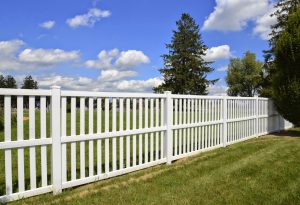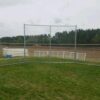 Vinyl fence initially has a higher cost, but, because it has no associated maintenance costs beyond an occasional cleaning, it’s a favorite option in fence materials. Vinyl won’t discolor, and won’t rot or attract termites. It’s the preferred fence material for those who don’t have the inclination to fuss with maintenance but still want an attractive fence. Vinyl comes in a wide assortment of colors and textures. It surpasses wood in strength, making it an ideal option for hard winter climates where heavy snow might be present.
Vinyl fence initially has a higher cost, but, because it has no associated maintenance costs beyond an occasional cleaning, it’s a favorite option in fence materials. Vinyl won’t discolor, and won’t rot or attract termites. It’s the preferred fence material for those who don’t have the inclination to fuss with maintenance but still want an attractive fence. Vinyl comes in a wide assortment of colors and textures. It surpasses wood in strength, making it an ideal option for hard winter climates where heavy snow might be present.
Vinyl and PVC are both used as fencing material. However, as far as synthetic fencing materials go, there isn’t a major downside to either vinyl and PVC fencing. But, it is important to note that there are a few fundamental differences, and it’s wise to know what they are, and what the particular fencing needs to your project are before you make your purchase. So, what exactly are the similarities and differences of these two types of materials?
PVC Fencing And Vinyl Fencing Similarities
Regarding the difference between the chemical composition of the two, there isn’t much difference between PVC and Vinyl. Vinyl is based on PVC but manufactured differently with a few things added to the process. When most people talk about PVC and Vinyl fencing, the terms are inclusive because the material is similar, even though there are different kinds of each.
PVC Fencing
PVC Fencing is, in most cases, refitting PVC pipes into use as a fence. PVC fencing is often used in third word countries because it’s economical. There are lots of different ways of doing it, and the technique and style varies from person to person. The problem with re-fitted PVC piping is that, as it can't be winterized, it doesn’t swell and shrink with the weather, which makes it more susceptible to breaking when it’s cold than the full vinyl fencing or the wood options.
Vinyl Fencing
Vinyl fencing is what people are talking about when they say “PVC fencing.” It’s a sturdy, functional, attractive, and comes in a wide assortment of color and texture options. It’s an easily installed and maintained fencing material.
Initially, it may cost more to have vinyl installed rather than wood, but the longevity of vinyl makes it a much more affordable option in the long term. It’s not susceptible to rot or termites and is easier to repair and replace in pieces than wood. It doesn’t require painting and is easy to clean.
Even though vinyl won't rot, there is one thing which should be noted: things like algae and mold will latch onto it and grow vigorously, sometimes to the point of staining or discoloration. Cleaning vinyl often is imperative to keep algae and mold from creating stains; dish soap and water mix are usually adequate for this purpose. Once vinyl acquires stains, the process of removing it is to wash, rinse, and repeat continuously for as long as it takes to remove the stain. It will eventually come off, but it’s a tedious process, so it’s better to catch a mold problem before it becomes widespread.
And the last consideration to a PVC vinyl fence is that it isn’t wood, even though it looks remarkably like a painted wooden fence from a distance. Up close, it’s easy to see that it’s a synthetic material, even though it’s beautiful in its own right. It’s a small consideration, but an essential one.

